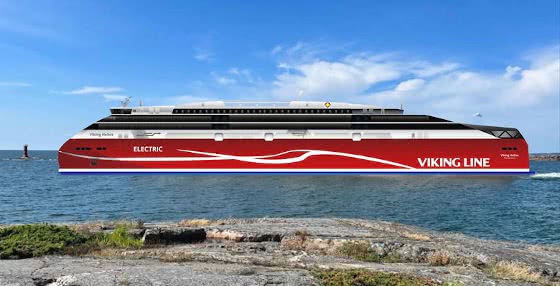
Finland's Viking Line has presented a project for the
construction of a ferry that, with a length of 195 meters,
a width of 30 and a carrying capacity of 2,000
passengers and 650 cars, it is expected to be the largest
Ro-Pax ship in the world entirely electrically propelled. The
shipping company intends to equip itself with the new unit
at the beginning of the next decade to use it on the
of 43 nautical miles between Helsinki and Tallinn. The new ship,
called Helios, will have a capacity of
batteries of about 85-100 megawatt hours and a speed of
cruising at about 23 knots. The project will stand out
mainly due to the absence of the funnel.
Zero-emission shipping in the Gulf of Finland is
promoted by the FIN-EST Green Corridor project which was
started by the cities of Helsinki and Tallinn, with founders and
partners that also include the ports of Helsinki and Tallinn, the
Estonian Ministry of Climate and the companies Viking Line, Rederi AB
Eckerö and Tallink Grupp. "It's fantastic - he
underlined the CEO of Viking Line, Jan Hanses -
that both cities and their ports have committed to creating
a green maritime corridor. Electric shipping does not
it is achieved only with naval investments. It also requires
efficient and reliable charging infrastructure in ports. The
port of call for the new electric ships - Hanses announced
- will be Jätkäsaari, where the port of Helsinki has in
development and expansion program until 2032.
The progress of this project is extremely important
for our plans." In Helsinki, in fact, the
The design of the expansion of the port area has been advanced
western to Jätkäsaari, where, according to forecasts,
Starting from 2032, all maritime traffic will be focused
with Tallinn.
According to forecasts from the Port of Helsinki, traffic
passenger between the city's western port area and
Tallinn will increase from 5.5 million passengers in 2024 to
11.6 million by 2040. Significant growth is also expected
of freight volumes. "The Helsinki-Tallinn route - explained
Hanses - recorded a particularly positive trend in the
last year and we believe that the volume will continue to increase:
There is a strong demand, based on need, for
connections between Finland and the Baltic countries. The rates for the
EU emissions trading and increasingly
restrictive measures - he observed - weigh more and more every year
on fossil fuel-based maritime traffic, but the
zero-emission technology would allow us to increase the
capacity on the route. Our goal - he specified
the CEO of Viking Line - is to order two
electric ships for the route, which would double our
current capacity put in place throughout the year".
